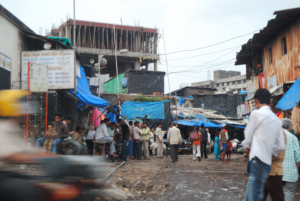Improving Living Conditions in Dharavi

Mumbai, India plays an integral role in improving living conditions in Dharavi. Being a port city, Mumbai is the commercial capital of India, having operations in the manufacturing and finance sectors. Mumbai is also home to many Bollywood films. The population of Mumbai estimates over 20 million residents. The reason for this increase is because of the squatter settlements. One major squatter settlement is Dharavi, which is home to 1 million people. Dharavi is located between two railway lines on a low-lying land once a garbage dump. A highway that divides the formal city from the informal city determines which areas are slums and which areas are not. A slum is a term that people use to identify unauthorized and illegal residents. Slums often lack basic amenities, including safety measures.
The Characteristics of Squatter Settlements
- Noisy, overcrowded and smelly.
- Cardboard houses.
- Lack of proper sanitation.
- Increase of population and disease.
- Strong sense of community.
Despite the stigma of slums, Mumbai is home to well educated, middle-class people who simply do not have adequate housing. Mumbai has been its own micro-industry. For example, it is most prosperous in the making of pottery.
Facts About Mumbai
The world’s population is 7.3 billion since 2011 and the highest growth is in low-income developing countries. Today, 50 percent of the world’s population lives in urban areas. Urban growth, also called rapid urbanization, is often located in low-income developing countries, as well as emerging and developing countries. The cause of urban growth can be due to natural diseases and migration. Moreover, the job prospects are low and crime and pollution levels rise when the population increases.
The population of Mumbai continues to increase in thousands each year. Some have cited that this could be because of the “push and pull factor,” which is when people leave rural areas for a more urban way of life. Lack of employment or housing can also push people out of rural areas. However, there may be some benefits for urbanization such as increased cultural wealth, more knowledge and skills in the city community and increased economically active elements of the community.
The Vision Mumbai Project
The Vision Mumbai project is improving living conditions in Dharavi by replacing squatter settlements with higher quality flats. With this project, there would be more schools, more shops, better health care centers, better roads and more jobs. Estimates determine the cost to improve the living conditions of Dharavi as 2 billion euros, however.
The current slum redevelopment is based on the government’s initiatives in 1995. Today, private developers can purchase slum land from the government at 25 percent of the fair market value and redevelop it. This means utilizing a plan and developing tools to control population density. Further, they can use building designs to secure safety and health initiatives.
With purchasing and obtaining 70 percent of slum dwellers’ consent, the project is moving forward by removing the dwellers and re-housing them in a free of cost multi-story building. However, the project will only provide this to slum dwellers who can show proof that they occupied the residence prior to Jan. 1, 2000.
Also, on other land areas, the developers may construct other buildings and sell them on the market as a free sale component. An example of this would be the Imperial Towers, the tallest building and one of the most expensive in India. It is obvious the redevelopment initiative has brought growth to the country as real estate in this area has grown since then.
The Slum Redevelopment Authority
The government of Maharashtra implemented an oversight agency called the Slum Redevelopment Authority in 1997. This agency was responsible for evaluating and approving slum redevelopment proposals. In the past two decades, it reestablished and rehabilitated .15 million tenements, as well as approved .12 million more that are waiting to begin.
Another step in improving living conditions in Dharavi includes the implementation of a motorized concrete producer. On April 1, 2012, Dharavi received a motorized rickshaw that weaves around the slums carrying 15-liter buckets of slow-setting concrete. Due to this innovation, residents can add on to their homes. Houses are more spacious, stronger, safer and more comfortable. This adds to a better quality of life for each resident and a start to better living conditions in Dharavi.
– Michelle White
Photo: Flickr
